ASIA ELECTRONICS INDUSTRYYOUR WINDOW TO SMART MANUFACTURING
ROHM Offers Better Insulation Resistance in SiC SBD
ROHM Co., Ltd. has developed a surface-mount SiC Schottky barrier diode (SBD). Primarily, it extends the creepage distance(*1) between terminals to increase insulation resistance. Particularly, the lineup includes eight SCS2xxxNHR models for automotive devices such as on-board chargers (OBCs). Additionally, eight SCS2xxxN models for industrial equipment such as FA equipment and PV inverters will also be available from Dec. 2024.
The center pin at the bottom of the conventional package has been removed. Also, the original ROHM package has adopted a unique shape. This extends the creepage distance to a minimum of 5.1mm, which is about 1.3 times that of general products. Tracking between terminals (creepage discharge) (*2) can be suppressed by securing a long creepage distance. Thus, there is no need for insulation treatment by resin potting (*3) when surface mounting the device on a substrate in high-voltage applications.

Additionally, the new SiC SBD is available in two types of withstand voltages, 650V and 1200V. Accordingly, it can be used in 400V systems, which are widely used in xEVs (electrified vehicles), as well as in higher voltage systems, which are expected to be used more in the future. In addition, since it can be mounted on a common land pattern with general products and conventional products in the TO-263 package, it can be replaced with existing circuit boards. In addition, the SCS2xxxNHR for automotive applications is compliant with the AEC-Q101(*4) automotive reliability standard.
Sample shipments of the new products began in September 2024. The company uses the ROHM Apollo Chikugo Plant (Fukuoka Prefecture) as production base for the front-end process. Meanwhile, ROHM Korea Corporation (Korea) is used for the back-end process. Internet sales have also started through One Stop ™, Core Staff Online ™, etc.
ROHM will continue to work on the development of high-voltage SBDs using SiC. It will contribute to energy conservation and higher efficiency in automobiles and industrial equipment by providing optimal power devices that meet market needs.
Background
In recent years, power semiconductors have become indispensable for OBCs and other components installed in xEVs. Also, there is a growing demand for SiC SBDs that generate less heat and combine high-speed switching performance with high breakdown voltage performance. In particular, the need for small, mountable surface-mount (SMD) packages is accelerating as they lead to increased application productivity. However, since tracking is likely to occur due to the application of high voltage, there is a need for a device that secures a longer creepage distance.
As a leading SiC company, ROHM has been working on the development of high-performance SiC SBDs that combine high mountability with high-voltage withstand performance. This time, the company has developed this product with minimum creepage distance of 5.1mm and has high insulation performance. To this end, it adopted a unique shape for the package.
Glossary:
*1) Creepage distance
The shortest distance between two electrical conductors (terminals) along the package surface of a device. In semiconductor design, it is necessary to take insulation measures by securing creepage distances and space distances in order to prevent electric shocks, leakage currents, and short circuits (short circuits) in semiconductor products.
*2) Tracking (creepage discharge)
A phenomenon in which a high voltage is applied to a terminal, which is an electrical conductor, and a discharge occurs through the surface of the package, which is an insulator. Discharges occur between patterns that should not be conducted, causing dielectric breakdown of the device. It is more likely to occur as the creepage distance becomes shorter due to the miniaturization of the package.
*3) Resin potting
The device body and the electrode connection between the device and the circuit are sealed with a resin such as an epoxy agent to provide electrical insulation. It is also effective in protecting the device, waterproofing, dustproofing, and improving durability and weather resistance.
*4) Automotive reliability standard AEC-Q101
AEC is an abbreviation for Automotive Electronics Council, and is a reliability standard for automotive electronic components that was formulated by a gathering of major automobile manufacturers and major electronic component manufacturers in the United States. Q101 is a standard applied to discrete semiconductor components (transistors, diodes, etc.).
This is an online translation of a Japanese press release with minor editing made by Dempa.
-12 November 2024-




